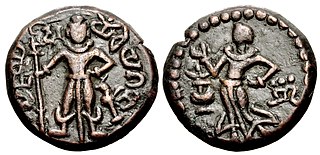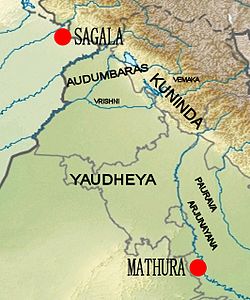
Demetrius I Anicetus, also called Damaytra was a Greco-Bactrian and later Indo-Greek king, who ruled areas from Bactria to ancient northwestern India. He was the son of the Greco-Bactrian Kingdom's ruler Euthydemus I and succeeded him around 200 BC, after which he conquered extensive areas in what is now southern Afghanistan, Iran and Pakistan and India.

Agathocles I Dicaeus was a Greco-Bactrian/Indo-Greek king, who reigned between around 190 and 180 BC, likely of the dynasty of Diodotus I, due to his commemoration of Antiochus Nicator.

The Coinage of India began anywhere between early 1st millennium BCE to the 6th century BCE, and consisted mainly of copper and silver coins in its initial stage. The coins of this period were Karshapanas or Pana. A variety of earliest Indian coins, however, unlike those circulated in West Asia, were stamped bars of metal, suggesting that the innovation of stamped currency was added to a pre-existing form of token currency which had already been present in the Janapadas and Mahajanapada kingdoms of the Early historic India. The kingdoms that minted their own coins included Gandhara, Kuntala, Kuru, Magadha, Panchala, Shakya, Surasena, Surashtra and Vidarbha etc.

The Triratna is a Buddhist symbol, thought to visually represent the Three Jewels of Buddhism.

The Audumbras, or Audumbaras (Hindi;ओदुम्बर) were a north Indian tribal nation east of the Punjab, in the Western Himalaya region. They were the most important tribe of the Himachal, and lived in the lower hills between Sirmaur, Chamba and Yamuna.
The Western Satraps, or Western Kshatrapas were Indo-Scythian (Saka) rulers of the western and central parts of India, between 35 and 415 CE. The Western Satraps were contemporaneous with the Kushans who ruled the northern part of the Indian subcontinent, and were possibly vassals of the Kushans. They were also contemporaneous with the Satavahana (Andhra) who ruled in Central India. They are called "Western Satraps" in modern historiography in order to differentiate them from the "Northern Satraps", who ruled in Punjab and Mathura until the 2nd century CE.

The History of the Indo-Greek Kingdom covers a period from the 2nd century BCE to the beginning of the 1st century CE in northern and northwestern Indian subcontinent. There were over 30 Indo-Greek kings, often in competition on different territories. Many of them are only known through their coins.

Yaudheya (Brahmi script: 𑀬𑁅𑀥𑁂𑀬) or Yoddheya Gana (Yoddheya Republic) was an ancient militant gana (confederation) based in the Eastern region of the Sapta Sindhu. The word Yaudheya is a derivative of the word from yodha meaning warriors and according to Pāṇini, the suffix '-ya', was significant of warrior tribes, which is supported by their resistance to invading empires such as the Kushan Empire and the Indo-Scythians. Rudradaman I of the Western Satraps notes in his Junagadh rock inscription that the Yaudheyas were 'heroes among all Kshatriya' and 'were loath to surrender'. They were noted as having a republic form of government, unique from other Janapadas which instead maintained monarchies.

Arjunayana, Arjunavana, Arjunavayana or Arjunayanaka was an ancient republican people located in Punjab or north-eastern Rajasthan. They emerged as a political power during the Shunga period. In the Allahabad Pillar Inscription of Samudragupta, the Arjunayanas figure among the autonomous political communities bordering on the Gupta Empire who accepted the overlordship of Samudragupta. They are also mentioned in Bṛhat Saṃhitā of Varahamihira. According to Dr Buddha Prakash, the Arjunayanas are mentioned as Prajjunakas in Kautiliya's text Arthashastra which also places them in the northern division of India. Vincent Smith locates their republic in Alwar and Bharatpur states now in Rajasthan, a view which has been rejected by R. C. Majumdar. They are mentioned in the literary sources in Afghanistan from 4th century BCE and after Alexander's invasions in 3rd century they have been mentioned in Agra, Mathura and Southern Haryana region till 4th century CE where their coins have been found too.

Amogh was a king of the Kuninda Kingdom in northern India, during the late 2nd century BCE to early 1st century BCE.

Chashtana was a ruler of the Saka Western Satraps in northwestern India during 78-130 CE, when he was the satrap of Ujjain.

The Indo-Greeks practiced numerous religions during the time they ruled in the northwestern Indian subcontinent from the 2nd century BCE to the beginning of the 1st century CE. In addition to the worship of the Classical pantheon of the Greek deities found on their coins, the Indo-Greeks were involved with local faiths, particularly with Buddhism, but also with Hinduism and Zoroastrianism.

Indo-Greek art is the art of the Indo-Greeks, who reigned from circa 200 BCE in areas of Bactria and the Indian subcontinent. Initially, between 200 and 145 BCE, they remained in control of Bactria while occupying areas of Indian subcontinent, until Bactria was lost to invading nomads. After 145 BCE, Indo-Greek kings ruled exclusively in parts of ancient India, especially in Gandhara, in what is now present-day the northwestern Pakistan. The Indo-Greeks had a rich Hellenistic heritage and artistic proficiency as seen with the remains of the city of Ai-Khanoum, which was founded as a Greco-Bactrian city. In modern-day Pakistan, several Indo-Greeks cities are known such as Sirkap near Taxila, Barikot, and Sagala where some Indo-Greek artistic remains have been found, such as stone palettes.

The sources used to reconstruct the history of the Indo-Greeks are few and disparate, leading to much uncertainty about the precise state of the Indo-Greek kingdom and its chronology. Sources related to the Indo-Greeks can be classified into various categories: ancient literary sources from both the West and the Indian world, archaeological sources from the general area of present day Pakistan, Kashmir and North Indian states of Punjab, Haryana, Himachal Pradesh, Uttar Pradesh & Bihar, and numismatical sources, which are abundant and well-preserved but often rather cryptic.
The Kanet is a caste found in the state of Himachal Pradesh in North India. They are generally regarded as a Thakur (noble) caste, even though they have sometimes been classified otherwise.There is the subcaste of kanets which is known as "Mukhiya".
The Northern Satraps, or sometimes Satraps of Mathura, or Northern Sakas, are a dynasty of Indo-Scythian ("Saka") rulers who held sway over the area of Punjab and Mathura after the decline of the Indo-Greeks, from the end of the 1st century BCE to the 2nd century CE. They are called "Northern Satraps" in modern historiography to differentiate them from the "Western Satraps", who ruled in Sindh, Gujarat and Malwa at roughly the same time and until the 4th century CE. They are thought to have replaced the last of the Indo-Greek kings in the Punjab region, as well as the Mitra dynasty and the Datta dynasty of local Indian rulers in Mathura.
The Yavanarajya inscription, also called the Maghera Well Stone Inscription, was discovered in the village of Maghera, 17 kilometers north of Mathura, India in 1988. The Sanskrit inscription, carved on a block of red sandstone, is dated to the 1st century BCE, and is currently located at the Mathura Museum in Mathura. The inscription notes the donation of a water well and tank to the community in 1st century BCE, built by a Brahmana.

Post-Mauryan coinage refers to the period of coinage production in India, following the breakup of the Maurya Empire.

The Art of Mathura refers to a particular school of Indian art, almost entirely surviving in the form of sculpture, starting in the 2nd century BCE, which centered on the city of Mathura, in central northern India, during a period in which Buddhism, Jainism together with Hinduism flourished in India. Mathura "was the first artistic center to produce devotional icons for all the three faiths", and the pre-eminent center of religious artistic expression in India at least until the Gupta period, and was influential throughout the sub-continent.

The Reh Inscription was discovered in 1979 near the Reh archaeological site along Yamuna River about 350 kilometres (220 mi) east of Mathura in India. It is a Prakrit inscription in Brahmi script near the bottom of a Shiva linga. The inscription is dated to between the 2nd century BCE and 2nd century CE based on the script style.



















